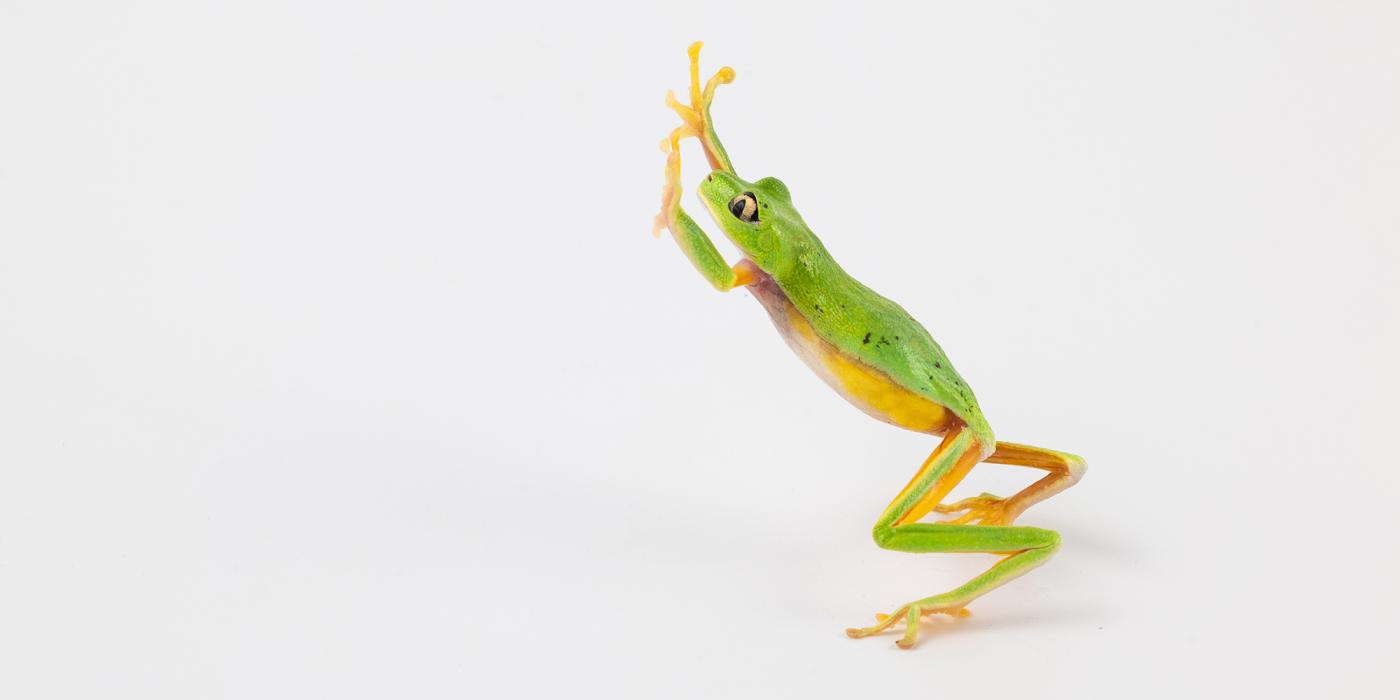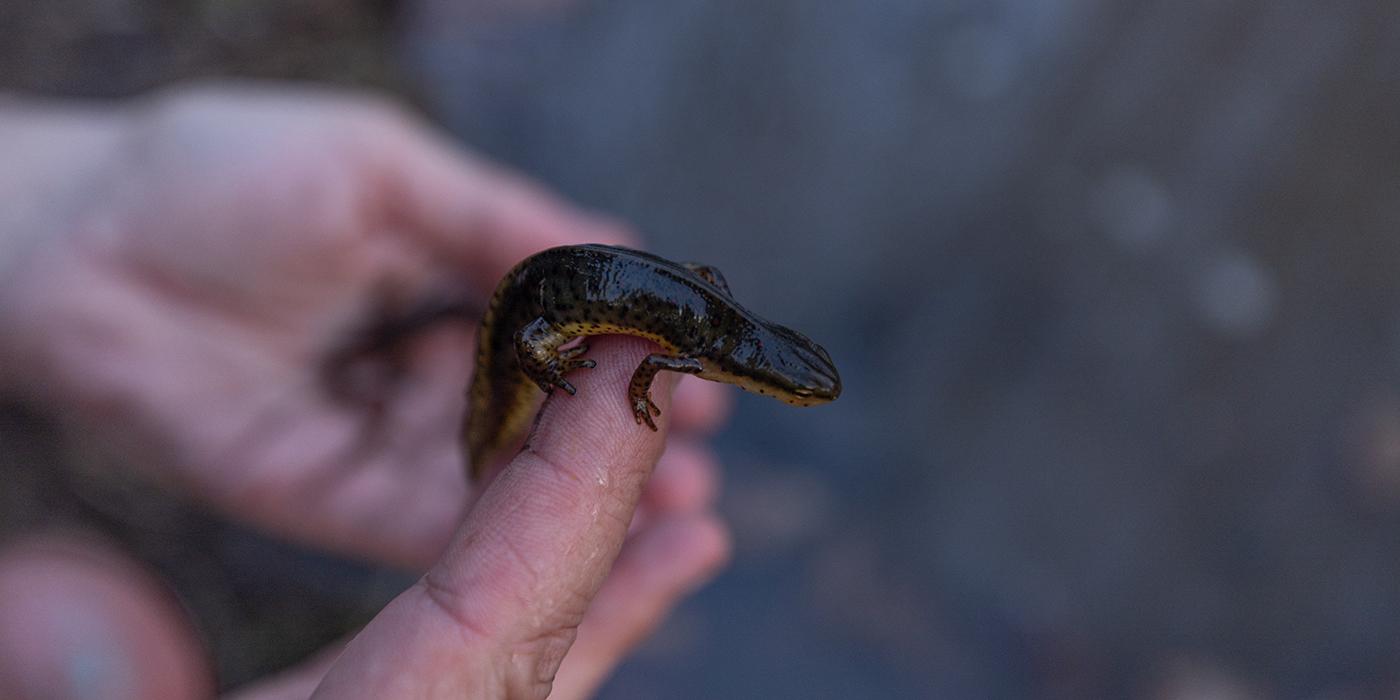New at the Zoo: Japanese Giant Salamander

A supersized salamander recently debuted at the Smithsonian’s National Zoo’s Reptile Discovery Center. Japanese giant salamanders breathe through their skin, have impossibly small eyes and can grow up to 5 feet long! Get the scoop on these freshwater giants from keeper Kyle Miller.
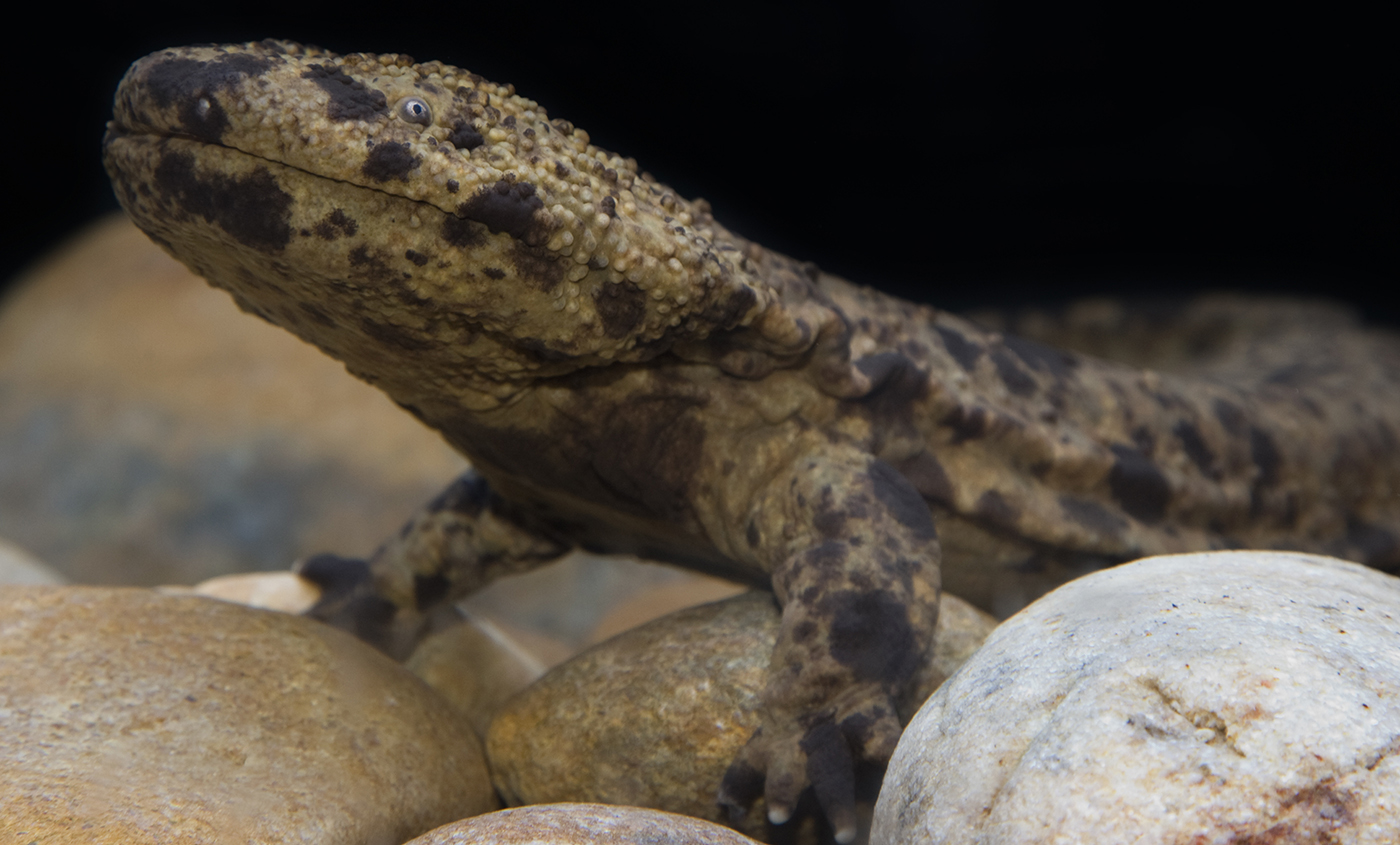
What makes Japanese giant salamanders unique?
Their size has always impressed me. Japanese giant salamanders are the second-largest salamander species in the world. They can get up to 5 feet long and weigh 55 pounds. They have this big tail that is laterally compressed (flattened from side to side) that helps them move through the water. We see that with the other salamanders in the cryptobranchid family, including the Chinese giant salamander and the hellbender. They are very slow-moving though, so they don’t take off swimming a lot.
People think of amphibians as delicate, but Japanese giant salamanders are very tough and resilient. Males get a lot more aggressive and active during the breeding season and will fight with each other. They can get beat up, but they heal like Wolverine. They can even lose limbs and recover just fine, even though their limbs won’t grow back.
How do they breathe underwater?
Oxygen goes in through their skin and carbon dioxide goes out – that’s how the respiration process works underwater. These guys are very long and flat, and they have folds in their skin that create a lot of surface area for that respiration to occur. They also live in fast-moving streams, and moving water tends to have more dissolved oxygen than still water. If they get caught in stagnant water, they will actually rock their bodies to get the water moving so that they can keep breathing.
Tell us about the Japanese giant salamanders that live at Reptile Discovery Center.
We have four Japanese giant salamanders at the Zoo – two females and two males – that were gifted to us from Asa Zoo in Japan in 2009. They are already about 2 feet long, and our biggest male weighs about 6 kilograms (13 pounds). He was named Hiro by the Japanese Ambassador to the U.S. in 2010. We refer to the other three by their physical characteristics: Orange Male, Full-tail Female and Notch-tail Female.
The girls are both really chill. Orange Male tends to be the greediest and to beg for food the most. Hiro tends to be the most aggressive, so he is kind of the bully of the group. If they are all hanging out in the same den and he wants to be in that space, he will push his way in – even if the other salamanders are blocking the entrance. Orange Male lives on exhibit right now, while the others live in the breeding area behind the scenes. They are all about 20 years old, but Japanese giant salamanders have been recorded living over 50 years in human care. We wouldn’t be surprised if these guys live to be 60 or 70.
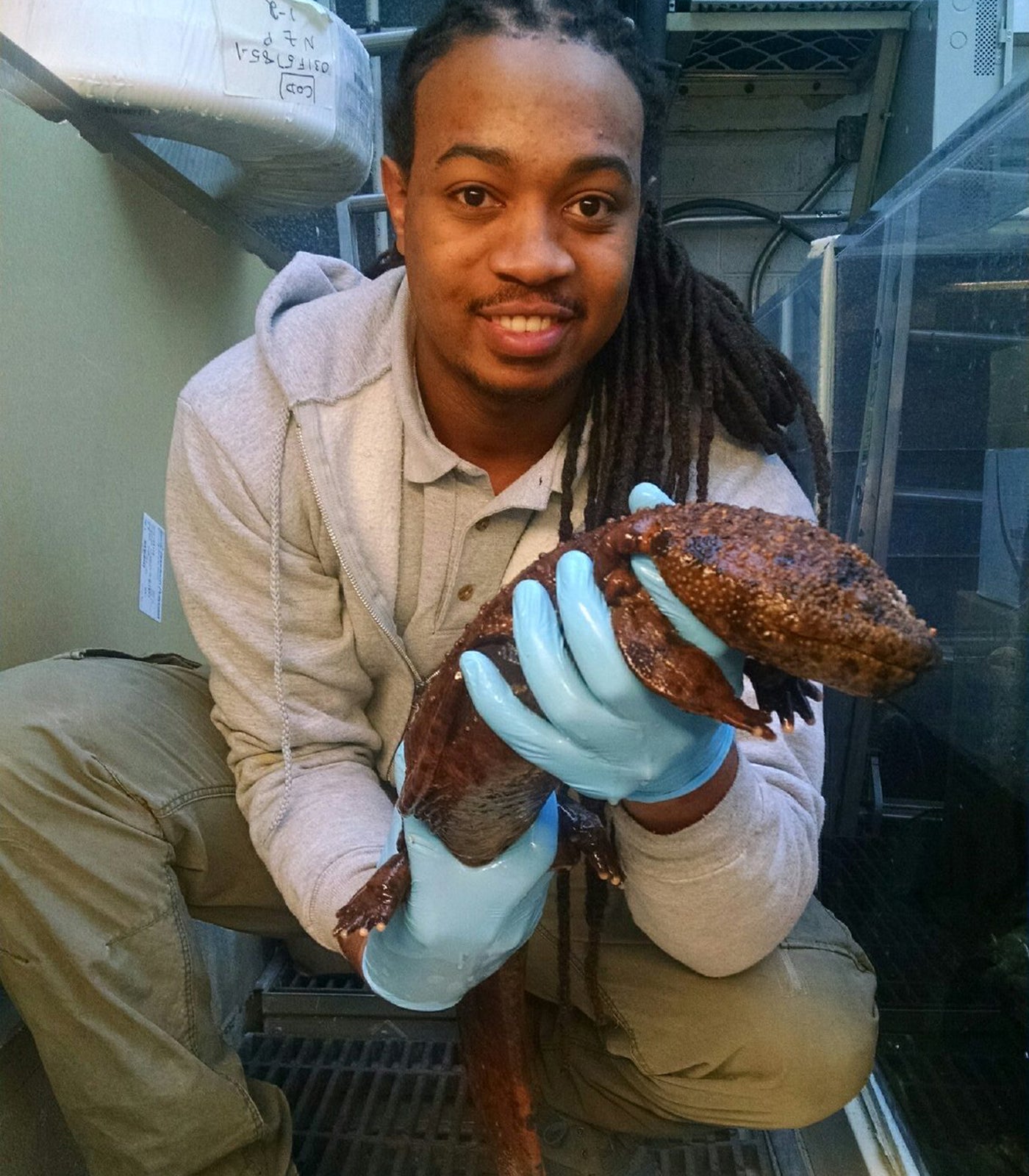
How do you weigh a Japanese giant salamander?
We have a little tub that we put them in, and that goes on a scale. It’s a really quick process. We use a net to get them out of the water and into the tub, weigh them and then gently ease them back into the water. They do have sharp teeth and can bite really hard, so we are very careful to stay away from the head. We also work quickly so they don’t get too agitated.
Has the Zoo had success breeding Japanese giant salamanders?
Not yet, but we are always trying new things and think we are getting closer every year. Honolulu Zoo was the first to get eggs in a North American zoo. That was last year, but the eggs didn’t develop. Male Japanese giant salamanders grow faster than females, so our males are already sexually mature. Females reach sexual maturity when they are about 23.5 inches long. Our females are 18.8-20.5 inches now and still growing.
What are some of the challenges?
Honestly, it’s replicating the water that is found in their wild streams. Asa Zoo in Japan, where they have the most success breeding, has something called an “open system.” It uses water from the streams where the animals are naturally found. We use a temperature cycling system and play with different water levels. In seasons when there would be heavier rains in Japan, we raise the water level. When it’s warmer and drier, we lower the water level. We are trying to trigger them with the same cues that they would have in the wild, without any interference from keepers.
Trying to do that artificially is very challenging, but hopefully we will find the right recipe. We also try to replicate their underwater den sites where breeding takes place and the eggs are laid and fertilized. In the wild, den sites would be rocks and caves. Our artificial dens are basically hollow PVC tubes that lead to upside-down flowerpots. They are based off what our colleagues at Asa Zoo use. Our salamanders will also shack up in the dens and use them as a lounge spot. Japanese giant salamanders are nocturnal, so they pretty much sleep all day.
What does their typical breeding season look like in the wild?
The breeding season starts in July and has been recorded going as late as November. Each den site has one big, dominant male who is considered the den master, but multiple females will come in and out to lay eggs. They each lay about 400 to 600 eggs, and the male fertilizes the eggs. Different males will also sneak in to participate in that process, but the den master is ultimately the top dog of that space.
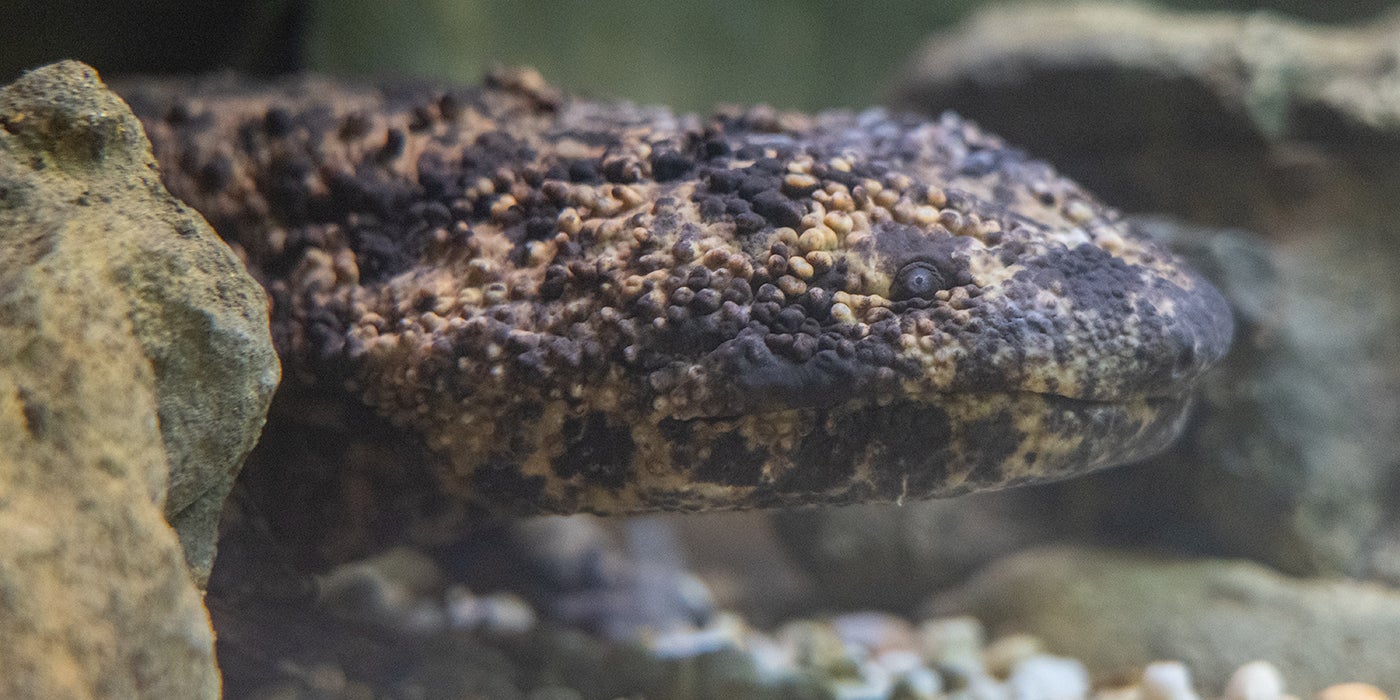
Who takes care of the eggs?
The dad actually cares for the eggs, so that is really cool. It’s not common to see paternal care in reptiles and amphibians. The male will seek out the den site and prepare it for the females. After the eggs are laid and fertilized, he guards the den, keeps it clean and fans the eggs with his tail. Stagnant water is no good for salamander eggs in their development, so fanning the eggs helps to keep them well-oxygenated. Recent research has shown that the male will provide care for up to seven months – even after the offspring hatch, at which point he mostly serves as a guardian. The young salamanders initially live off their yolk sac and then start to hunt on their own.
What is special about their new habitat here at the Zoo?
The exhibit itself was designed to be completely naturalistic. We replicated the rockwork that is found in the streams where they live in the wild, including the substrate (rocky bottom). We set up the cave in a way that guests can walk right up and look into it. We are also playing with different lighting effects. Right now, I have it set up as a nocturnal exhibit, which I hope will encourage Orange Male to be a little more active during the day when guests are here.
What do Japanese giant salamanders eat?
We feed them smelt, shrimp, herring, and occasionally tilapia filets or live crayfish feedings. Shrimp and smelt seem to be their favorite. Every few months or so I’ll also cut up some squid and give it to them. Full-tail Female really goes crazy for that.
In the wild, Japanese giant salamanders primarily feed on fish and crustaceans, as well as smaller amphibians. There have also been records of them eating small mammals, so they are very opportunistic feeders and have a voracious appetite. If something is the right size and swims in front of them, they will go after it. They have terrible vision, so they count on their sensory organs. Their bodies are covered in tubercles that help them sense their way around and pick up on the movement of prey. They have a good sense of smell as well.
Is it true that they shed their skin?
Yes, they will shed their skin as they grow – and they actually eat it. We see that with different species of reptiles and amphibians, like leopard geckos. As young animals, these salamanders shed their skin about once a month. It gets less and less frequent as they get older and grow more slowly. Our salamanders shed their skin about four to five times a year.
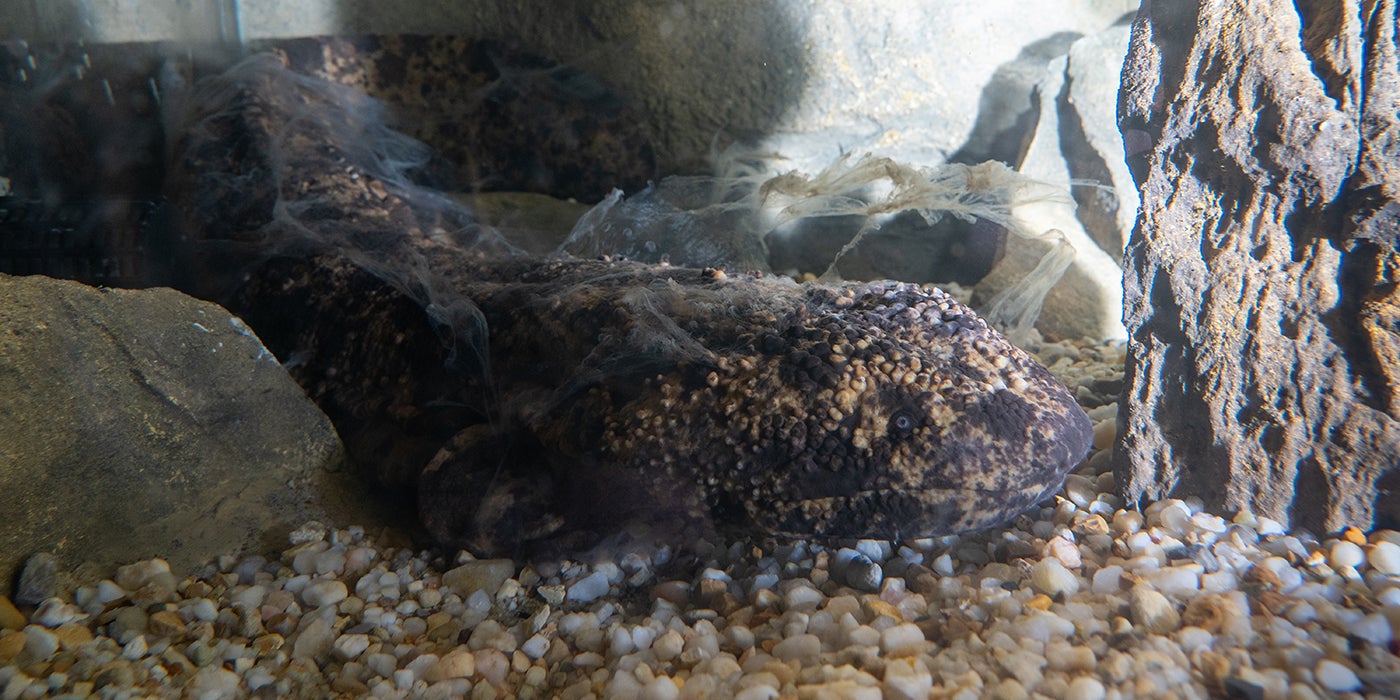
Are they solitary or social animals?
They are pretty solitary and not very social throughout the year. Sometimes we find our Japanese giant salamanders peacefully hanging out in one den, but then for weeks at a time we see them each hiding in a separate den or tube.
What is your favorite part about working with Japanese giant salamanders?
These guys are not found at most zoos in the U.S., so just having them as part of our collection is rewarding. Experimenting with the environment to better match the habitat they experience in the wild is always a fun part of the job. Even though it can be frustrating and challenging, constantly working toward that process of being the first to get them to successfully breed in North America (and really outside of Japan) is very exciting.
I have always been a fan of the giants of the reptile and amphibian group, too – giant geckos, goliath bullfrogs, giant anacondas. When you think salamander, you think of this little thing that fits in the palm of your hand. But this is a salamander that can get to 55 pounds. It’s always exciting to work with such a cool amphibian.
Though the Zoo is temporarily closed to the public, keepers continue to provide the highest quality of animal care to all its residents. Want to help replenish toys, puzzle feeders and training tools that are a bit run-down yet well loved by the Zoo’s animals? Donate to the Enrichment Trunk. Your support directly benefits the animals at the Smithsonian’s National Zoo and Conservation Biology Institute.
This story appears in the April 2020 issue of National Zoo News.
Related Species:
